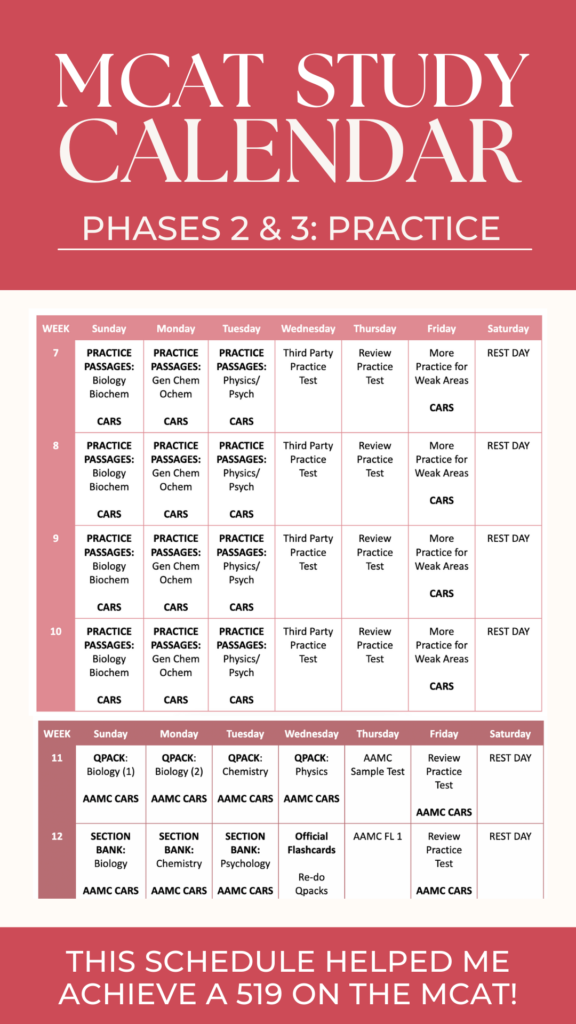Hi everyone! I’m back with another MCAT guide, and this time, I’m sharing my MCAT Content Review calendar and daily study schedule with you. If you haven’t already read my 2 previous posts on frequently asked MCAT questions and the top MCAT study resources, please do so first because a lot of what I share below will make more sense.
I also want to remind you that you do not need to practice everything that I share. You know your study needs and preferences best! Please use my guides as inspiration for how to study, and adapt it to suit your individual style! Feel free to DM me on TikTok or email me at p31beauty@yahoo.com if you ever have any questions. I’m always here to help! Now let’s dive into the best way to tackle Content Review for the MCAT!
Previous MCAT Posts:
MCAT 101: Everything You Need to Know Before Studying for the MCAT
The Best MCAT Study Material I Used to Score a 519


MCAT STUDY TIMELINE
I recommend splitting your MCAT study journey into three different phases:
- Content Review
- 3rd Party Practice
- Official AAMC Practice
You might be wondering, How long should I spend on each phase? This is something that will vary depending on each person’s availability and previous knowledge of MCAT topics. Some people are able to evenly split their time on each phase (ex: one month per phase). However, if you need to learn a variety of MCAT topics on your own or if you’re struggling with practice questions, you may need to invest more time on certain phases.
Personally, I was able to do a somewhat even split of each phase over the course of 4 months because I had taken classes that covered most of the MCAT topics. However, I did have to spend a few more weeks on content review because I had to learn Psychology/Sociology from scratch. In just a bit, I’ll assist you in creating a MCAT study calendar. In the mean time, here’s a brief overview of what you should focus on during each phase.

@p31beauty Here’s the MCAT study timeline that I used to score a 519! ✨ Split up your MCAT study journey into these 3 phases. 📚 #mcatprep #premed #premedadvice #premedmentor #studytok #collegeadvice #mcat #firstgen #futuredoctor #studyhacks ♬ just like magic – Ariana Grande
PHASE 1: CONTENT REVIEW
CREATE YOUR OWN CONTENT REVIEW STUDY SCHEDULE
Before we dive into the specifics of your Content Review Phase, we need to create a study schedule for you! Your Content Review schedule will be determined by how much time you can commit to studying. Read my last post if you need advice on how long to study for.
Once you have determined the amount of time you can dedicate to studying, divide the number of WEEKS by 3 (since there are 3 phases). That value should give you a rough estimate of how many weeks you should dedicate to each phase. Feel free to add an extra week or two to each phase in the event that your study schedule gets interrupted.
For example, if you plan to study for 12 weeks (3 months), Dedicate around 4-5 weeks to the Content Review phase.
Next, determine how many days a week you are able to study. To avoid burnout, try to have at least 0.5 to 1 day of rest where you don’t do anything MCAT related.
For example, if you plan to have 1 rest day/week, that would give you an estimated total of (4 to 5 weeks x 6 study days) 24 to 30 days of Content Review.
Now, you need to split up your review videos or chapters across your Content Review days. Everyone’s schedule is going to look different, so this part is up to you to figure out! I’ll show you how I set up my study schedule.
MY DAILY STUDY SCHEDULE
I studied for a little over 4 months, and my Content Review phase lasted around 6 weeks with 1 rest day/week. As I mentioned in my previous post, I used the Kaplan books for Biochemistry, Biology, General Chemistry, Organic Chemistry, and Physics. I did not read the CARS or Psychology books. Instead, I used third party CARS practice websites and watched all of the Khan Academy Psychology/Sociology videos.
Everyday, I focused on 2 subjects and read 1 chapter for each subject (2 chapters per day). For Psychology/Sociology, I divided the Khan Academy videos across all my pysch/soc days. In addition, I did daily CARS practice. Remember, if you’re relying on review books, you can always watch Khan Academy videos on other sections if you find a topic very challenging!
HERE’S HOW I SPLIT UP MY DAYS DURING THE CONTENT REVIEW PHASE:
DAYS 1 & 4:
Biochemistry + Biology
DAYS 2 & 5:
General Chemistry + Organic Chemistry
DAYS 3 & 6:
Physics + Psychology/Sociology
DAYS 1-6:
CARS (more details in the next section)
DAY 7:
Rest Day
MY CONTENT REVIEW PHASE CALENDAR
(CLICK TO DOWNLOAD)
This calendar is only for Phase 1 (Content Review). Download the calendar to edit and adjust it to your own study schedule! I’ll be sharing my calendars for Phase 2 & 3 very soon!

Now that we have your MCAT study schedule set up, let’s go into more detail on how you should approach the Content Review phase!
GOALS FOR THE CONTENT REVIEW PHASE
The Content Review phase is when you will be reviewing all of the topics that will be covered during the MCAT through your review books and/or Khan Academy videos. Remember, the MCAT will test you on both passage based AND discrete (stand-alone) questions. So, you won’t be required to memorize every intricate detail that you come across.
However, you will be required to recall key concepts for stand-alone questions and be able to APPLY key concepts for passage based questions. Keeping this in mind, don’t try to memorize every single detail that you read or watch during the Content Review phase. Instead, try to remember the key concepts that tend to be bolded/summarized in books or emphasized in videos. As you do more practice questions and tests, you will see a recurring pattern of topics that you truly need to memorize for the MCAT.
Here’s what you should do during the Content Review phase:
1. Take a Diagnostic Test
I highly recommend taking a diagnostic test at the very start of your MCAT journey to see how the MCAT is structured and to gauge which topics you need to focus on the most.
I suggest taking the free half length or full length Blueprint MCAT practice test. If you read my previous post, you know that Blueprint has challenging practice tests that will help prepare you for the actual exam. It’s up to you if you want to do a half or full length diagnostic test; if you want to see how mentally exhausting the real test is, do the full length!
After taking the test, use this exam review spreadsheet to keep record of what types of questions you missed and why you got it wrong. The purpose of this workbook is to find patterns of questions/topics that need improvement. As you continue taking practice tests, you want to make sure that you’re not making those same mistakes! This is such a great tool to easily pinpoint your weaknesses and improve your scores. Keep this workbook for future practice tests (but more on that later!).
Click to Download this MCAT Exam Review Spreadsheet (Source: Reddit)

2. Read through review books OR watch Khan Academy videos
If you haven’t already read my previous MCAT post, click here! In that post, I share all of the top resources that you need to ace the MCAT, including review books and Khan Academy.
When you’re reviewing, I highly recommend that you ONLY take detailed notes on topics that you’re learning from scratch or are challenging for you. For topics that you’re comfortable with, read through the section but only take notes on information that you’re unfamiliar with.
Remember, the MCAT mostly requires you to remember key CONCEPTS not details, so please don’t waste your time on taking notes/trying to memorize every single detail. Be sure to constantly review these notes or convert them to flashcards so that you don’t lose this information throughout many months of studying.
During my content review phase, I literally took detailed notes for EVERY chapter in the Kaplan books. And guess what? When I started the practice question review phase, I rarely looked back at my notes! Instead of taking detailed notes, I wish that I had done more practice questions because practice hits 2 birds with 1 stone. It allowed me to get a better sense of which concepts I truly needed to remember, and it tested me on whether I could actually APPLY my knowledge. Pure memorization is not going to cut it for the MCAT.
TLDR ON NOTE TAKING STRATEGIES
• For topics that you’re learning from scratch/are challenging for you:
READ THROUGH THE SECTION & TAKE DETAILED NOTES
• For topics that you’re comfortable with:
READ THROUGH THE SECTION & ONLY TAKE NOTES ON INFORMATION THAT YOU’RE UNFAMILIAR WITH OR FIND CHALLENGING
• Constantly review these notes or convert them to flashcards so that you don’t lose the information throughout months of studying
• Prioritize doing practice questions over taking detailed notes.
3. Do Practice Passages/Questions Related to The Chapters/Videos You Studied
One of my regrets is that I didn’t start doing practice passages during my Content Review phase. I did do the practice at the end of each Kaplan chapter. However, I feel that those questions are more similar to the MCAT’s discrete questions in that they only test your ability to recall information. Being able to read and analyze MCAT passages under a time constraint takes a lot of practice, so be sure to start early!
After reading chapters and/or watching videos for the day, do 1-2 practice passages for each chapter/topic that you covered. In my last post, I shared different resources in which you can access practice passages such as UWorld ($) and Khan Academy (Free). Doing practice passages will reveal whether you truly understood what you learned that day! Feel free to increase the amount of practice passages you do as time goes on.
Along with making flashcards for challenging topics that you study, I recommend creating flashcards when you come across practice questions/concepts that you get wrong or are confusing. It’s very important to understand why you got a question wrong and to retain the correct information in case it shows up on your actual exam!
4. Practice CARS Everyday
You don’t need to read any review books for CARS. The key to doing well with CARS is to practice everyday! I recommend starting off with 3-4 Jack Westin passages per day. Practice reading and answering questions for each passage in under 10 minutes since there are 9 passages and 90 minutes for the entire CARS section.
Everyone is going to develop their own strategy for approaching CARS. My personal strategy was to read the passage quickly without highlighting or taking notes in order to get the main idea. Then I went straight to the questions. For each question, I would go back to the part of the passage that directly corresponds to the question and read that section in depth.
Jack Westin’s (and every other third party resource!) CARS style is different from AAMC, so don’t get discouraged if their answer choices are really difficult or seem completely illogical. AAMC is much more straightforward; however, I would save the AAMC practice for after content review so that its question style/logic is fresh in your mind prior to taking the test.
Another free CARS resource that you can use is Khan Academy. However, I would save those for the 3rd Party Practice Phase because their passages and questions are more similar to AAMC! I recommend using Jack Westin during the Content Review phase as a way to develop your personal strategy on quickly reading and understanding challenging articles.
MY WORKFLOW FOR ANSWERING CARS QUESTIONS:
1) Read quickly and don’t get caught up on details/sentences that are confusing since the questions might not even ask about it.
2) Once you finish the passage, think about what the main idea was. Use this to guide you as you answer questions.
3) After reading a question, go back to the specific part of the passage that addresses the question. Choose the answer choice that directly relates to that specific section!
The MCAT likes to trick you by giving you answer choices that sound correct or relate to a different part of the passage. Don’t fall for it! Also, try not to make assumptions when answering the questions.
Always always always choose the answer that directly relates to the paragraph/sentence that the question stems from.
4) If none of the answer choices seem to relate to a specific part of the passage (rule 3), then choose the answer that most reflects the passage’s main idea!
Here’s what a workday during the Content Review Phase should look like:

Conclusion
Thanks so much for reading! Stay tuned for my next MCAT post where I’ll be sharing FREE calendars and study schedules for Phase 2 and 3 of your MCAT journey. If you have any questions, feel free to email me at p3beauty@yahoo.com, and follow me on TikTok for more pre-med advice! Good luck studying!
Love,
Blaze Ann
CLICK HERE TO READ MY PHASE 2 & 3 MCAT STUDY GUIDE!











